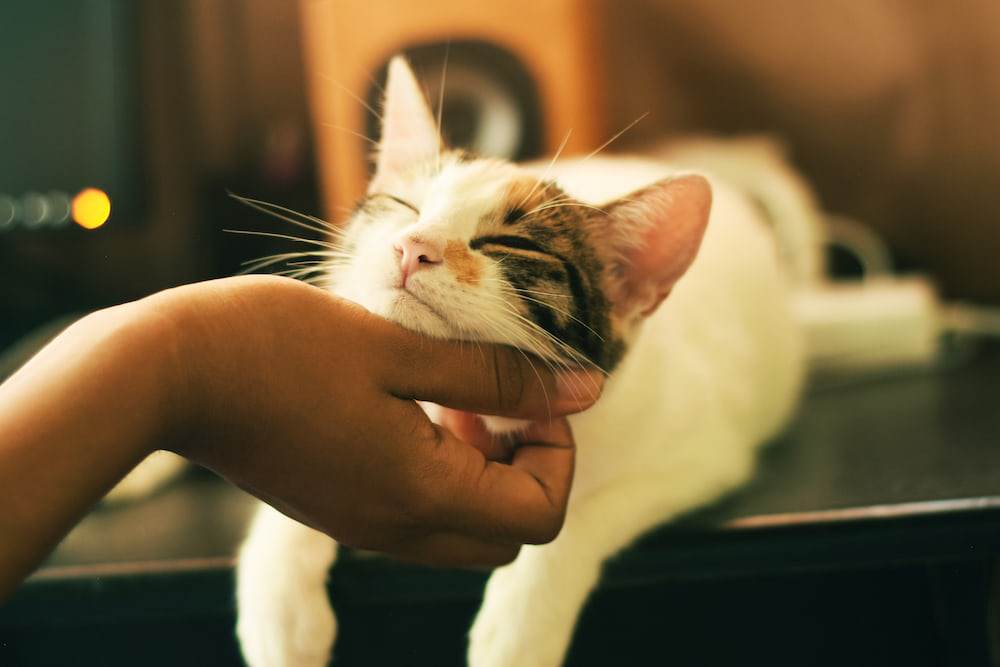12 Hints on How to Make Your Cat Sleep With You

Let’s discuss how to make your cat sleep with you…
Are you tired of your furry feline friend sleeping in another room instead of snuggling with you? Well, you’re not alone! Many cat owners crave the comfort and companionship of sleeping with their beloved pets.
Luckily, there are a few simple ways to coax your cat into sleeping with you that are easy to implement. In this brief article, we’ll share some tips to help you make your cat sleep with you! So, read on and get ready for some quality snuggle time with your kitty.
How To Make Your Cat Sleep With You
To make your cat sleep with you, there are several tips and tricks you can try which include keeping your cat active during the day, feeding your cat right before bedtime, placing a cat perch near your bed, using a supersoft comforter or nice fleece or wool blanket on your bed, offering playtime with toys, and showing affection.
A heating pad turned too low in the spot where you want your cat to sleep may also attract your cat. It is important to keep in mind that not all cats enjoy sleeping with their owners, so it is essential to respect your cat’s boundaries and preferences.
Ways to Make Your Cat Sleep With You

The following are some common ways to make your cat sleep with you:
1. Making your bed warm and safe for your cat
If you want your cat to sleep with you in the same bed, it’s important to make the bed warm and safe for your pet. Cats are creatures of habit, so creating a comfortable environment will help encourage them to cuddle up with you.
One way to make the bed warm and inviting is to add a soft and cozy blanket or pet bed on top of your bedspread. You can also add a heating pad or a hot water bottle underneath the bedding to keep the bed warm and cozy.
Additionally, make sure that the bed is safe for your cat by keeping any harmful objects out of reach and ensuring that your cat cannot fall off the bed or get trapped underneath the blankets. By creating a warm and safe space for your cat, you’ll increase the chances that your feline companion will want to curl up and sleep next to you.
2. Using treats and positive reinforcement
Using treats and positive reinforcement can be an effective method to get your cat to sleep with you in the same bed. First, start by placing your cat’s bed or favorite sleeping spot near your bed. Gradually move the bed closer to your bed each night until your cat is comfortable sleeping beside you.
Next, provide treats as positive reinforcement for good behavior. For example, if your cat sleeps peacefully in its new spot next to your bed, reward it with a treat in the morning. This rewards your cat for good behavior and reinforces the idea that sleeping near you is a positive experience.
It’s essential to avoid scolding or punishing your cat if it doesn’t sleep beside you. This could cause anxiety or fear, making it more challenging for your cat to sleep comfortably near you. Instead, continue to provide positive reinforcement and be patient in the process.
3. Offering playtime with toys on the bed
Offering playtime with toys on your bed can be a good way to encourage your cat to sleep with you in the same bed. Cats love to play and by providing playtime on your bed, you create a positive association between the bed and fun.
This can make your cat feel more comfortable and relaxed on the bed and more likely to stay on the bed for a longer period of time. Additionally, providing this playtime can help tire your cat out, making it more likely that they will sleep through the night on the bed.
Just be sure to choose toys that are appropriate for your cat’s age and play style, and always supervise playtime to ensure your cat stays safe.
Learn more about identifying when a cat trusts you.
4. Adding a soft blanket on top of your bedspread
Adding a soft and cozy blanket or pet bed on top of your bedspread for your cat is a great way to entice your cat to sleep with you in the same bed. Cats are known to love comfortable and cozy spaces, and providing a dedicated space for them can make them feel more at ease and comfortable in your bed.
The added layer of softness on top of your bedspread can also provide your cat with a sense of security and make them feel more relaxed in your presence. Additionally, it can help protect your bedspread from any dirt or hair that may come off your cat.
5. Offering gentle strokes and soothing petting
Gentle strokes and soothing petting can be a great way to help your cat feel calm and relaxed, which may increase the likelihood of them wanting to sleep with you. Cats are known for being independent, so it’s important to remember that they may not want to sleep in the same bed as their owner every night.
However, if your cat is open to the idea, providing gentle strokes and petting can be a way to show your cat affection and help them feel comfortable. It’s important to read your cat’s body language, as some cats may not enjoy being petted for long periods of time.
If your cat is showing signs of restlessness or discomfort, it’s best to respect their boundaries and give them space to sleep on their own. Overall, gentle strokes and soothing petting can be one of many techniques you can use to create a peaceful and comfortable sleeping environment for your feline friend.
6. Use familiar scents
Cats have a remarkable sense of smell, and they find comfort in familiar scents. To entice your cat to sleep on your bed, leave a piece of your clothing or an unwashed pillowcase on the bed.
Your scent will provide a sense of security and reassurance, making your kitty feel at ease and more inclined to spend the night cuddled up beside you.
7. Using gradual introductions
Some cats are more reserved and may not immediately take to the idea of sharing your bed. For a successful transition, introduce your cat to the bed gradually. Start by placing their favorite toy or treat on the bed to pique their curiosity.
Let them explore the space at their own pace without any pressure. As they become more familiar with the new environment, they’ll feel more comfortable considering it as a potential sleeping spot.
8. Making your cat feel secure

For cats, feeling safe and secure is essential for restful sleep. To create a secure environment, ensure that the sleeping area is calm and free from disturbances.
Cats are sensitive to sudden noises and changes in the environment, so try to create a soothing ambiance with soft lighting and gentle background noise. This will help your cat relax and associate the bed with tranquility.
9. Offering catnip
Catnip can work like magic in enticing your cat to sleep on the same bed as you. Catnip contains a compound called nepetalactone, which triggers a euphoric response in most cats.
Sprinkle a small amount of dried catnip on the bedding, or use a catnip-filled toy on the bed to create a positive association. The allure of catnip might just make your bed their new favorite sleeping spot.
Learn more about caring for your cat.
10. Respecting your cat’s personal space
Respecting your cat’s personal space is crucial in building trust and encouraging them to sleep on the same bed as you. Cats are independent creatures and appreciate having the freedom to choose their sleeping spot.
Avoid forcing them to sleep in a particular area or moving them if they’ve already found a comfortable spot. Giving them autonomy will make them feel more at ease and secure.
11. Bonding time during the day
Strengthen your bond with your cat during the daytime to make them more comfortable at night. Spend quality time together through interactive play, grooming sessions, or simply relaxing together.
Engaging in activities that your cat enjoys and providing them with love and attention during the day will naturally lead to them seeking closeness and comfort on the bed at night.
12. Patience and persistence
Patience and persistence are key when encouraging your cat to sleep on your bed. Cats are creatures of habit and may take time to adjust to new routines. Continue offering the opportunity for them to sleep with you, and be patient with their progress.
If they don’t immediately take to the idea, don’t be disheartened. Keep providing a warm and inviting bed, and in time, they might surprise you by joining you for a good night’s sleep.
Benefits of Letting Your Cat Sleep with You

Many cat owners love to snuggle with their furry friends in bed. Here are some of the benefits that come with letting your cat sleep with you:
1. Increased Bonding: Sleeping with your cat helps to strengthen your bond and create a deeper connection.
2. Decreased Stress: Cats are known to have a calming effect on their owners, so having your cat sleep with you can help reduce stress and anxiety.
3. Better Sleep Quality: Contrary to popular belief, studies suggest that sleeping with a cat can actually improve your sleep quality by providing a sense of comfort and security.
4. Warmth: Cats are warm creatures, and having them sleep next to you can provide a source of warmth and comfort on cold nights.
5. Safety and Security: Cats have excellent hearing and are exceptionally vigilant, which means they can help alert you to any potential danger while you sleep.
6. Emotional Support: If you’re feeling down or lonely, having your cat snuggled up next to you can be a source of emotional support and comfort.
Disadvantages of Letting Your Cat Sleep With You

Here are some disadvantages of letting your cat sleep with you:
- Sleep disruption: Cats are nocturnal animals and are naturally wired to be active at night. If your cat is active, it can wake you up or disrupt your sleep throughout the night, leading to fatigue, irritability, and decreased productivity during the day.
- Allergies: If you are allergic to cats, sleeping in the same bed with your cat can trigger allergy symptoms such as itchy eyes, runny nose, sneezing, and asthma.
- Hygiene issues: Cats can bring dirt, ticks, fleas, and bacteria from outside into your bed, which can be unhygienic and potentially harmful to your health.
- Aggressive behavior: Some cats can become aggressive in their sleep and scratch or bite their owners while sleeping, which can lead to injury or infection.
- Proximity to litter box: If your cat’s litter box is in your bedroom, sleeping in the same bed can expose you to unpleasant smells and possible infections.
- Sleep quality: While sleeping with a cat can offer comfort and companionship, it can also lead to poor sleep quality as your cat may move around or make noises throughout the night, disrupting your sleep cycle.
It’s important to weigh the pros and cons and make the decision that is best for you and your furry friend.
Related Questions
Why won’t my cat sleep with me?
There are a few reasons why your cat may not want to sleep with you. It could be that they prefer to sleep alone, they may not feel comfortable with your sleeping habits or movements, or they may simply prefer a different sleeping spot in the house. Don’t worry, it’s not personal!
Can I train my cat to sleep with me?
Yes, you can try to train your cat to sleep with you. Start by creating a comfortable sleeping spot for them on your bed, offering them treats and positive reinforcement when they come to sleep with you, and being patient if it takes some time for them to adjust to sleeping with you.
What if my cat keeps waking me up at night?
If your cat is waking you up at night, try to establish a bedtime routine for them, such as playing with them before bed and providing them with a comfortable sleeping spot. You can also consider giving them a small snack before bed to encourage them to sleep more soundly.
Should I allow my cat to sleep under the covers with me?
It’s up to you if you want to allow your cat to sleep under the covers with you. Just be careful to not accidentally harm your cat while you are sleeping, and make sure they have enough space to move around and breathe comfortably.
What if I’m allergic to my cat but still want to sleep with them?
If you are allergic to your cat, it’s best to avoid sleeping with them. Instead, try to create a comfortable sleeping spot for them in another room and spend quality time with them during the day.
Is it safe for my cat to sleep with me?
In general, it is safe for your cat to sleep with you. However, be cautious of accidentally harming your cat while you are sleeping and be aware of any potential health risks, such as allergies or parasites. If you are unsure, consult with your veterinarian for personalized advice.
Learn more about making your cat sleep at night.
Conclusion
In conclusion, making your cat sleep with you is not a difficult task, but it requires some patience and effort. Remember to create a comfortable and inviting sleeping environment for your feline friends, such as a cozy bed or a warm blanket.
Also, spend quality time with your cat before bedtime to help them relax and feel secure. With these simple tips, you’ll soon be enjoying sweet slumbers with your kitty snuggled up by your side. Happy snoozing!
